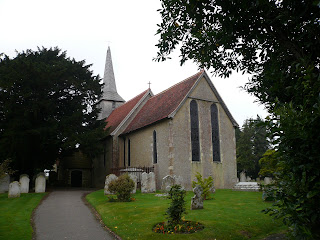 Ask most people what a typical Sussex church looks like and they will say it is a simple box with a small spire sticking out of the west end of the roof. St Andrew at Tangmere is just like that – a simple Norman nave, 13th century chancel and a shingle-clad spire. It is only when you go in that you see how unusual it is.
Ask most people what a typical Sussex church looks like and they will say it is a simple box with a small spire sticking out of the west end of the roof. St Andrew at Tangmere is just like that – a simple Norman nave, 13th century chancel and a shingle-clad spire. It is only when you go in that you see how unusual it is.
Stand inside most churches and you see little sign of the existence of the spire and its bell chamber, except for a rope dangling from a hole in the ceiling. At Tangmere, however, the whole west end is dominated by an extraordinary support structure for the bell-turret above, so the weight of the spire and the three bells is carried directly on the ground rather than the walls.
Four mighty posts stand on either side, supporting beams level with the top of the walls. Another pair of posts stands on each beam to hold up the bell chamber and spire above. The corners are strengthened by curved wind braces, forming a cat’s cradle of beams that gives a slightly barn-like feel to the interior.


Outside, the church has another odd feature: a crude carving above a tiny lancet window, possibly a Saxon fragment reused. It is so weathered it is difficult to make out, but it looks as though it depicts Herod presenting Salome with John the Baptist’s head on a plate. Rather gruesome.
In the immaculately-kept graveyard, ranks of white military headstones are carved with British and German names, no distinction being made between them.
